W. Li
User Identity Protection in EEG-based Brain-Computer Interfaces
Dec 13, 2024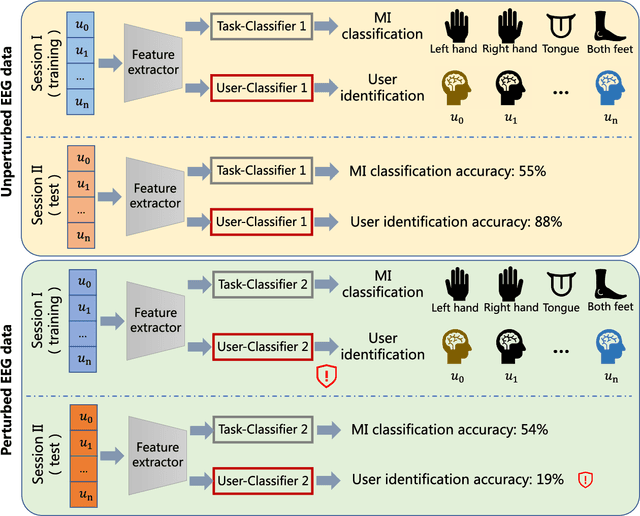
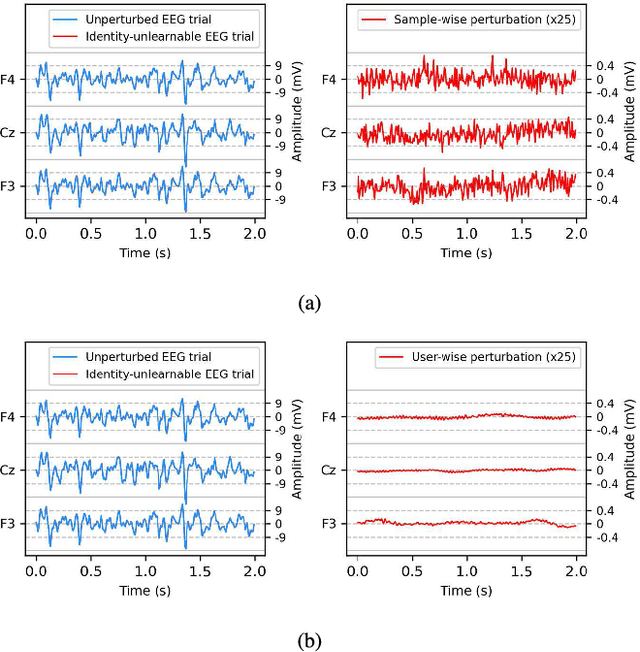
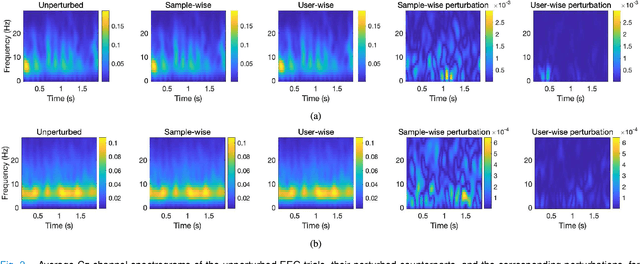
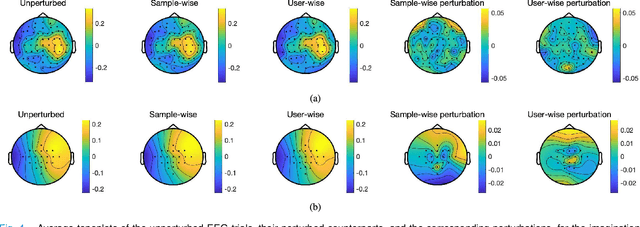
Abstract:A brain-computer interface (BCI) establishes a direct communication pathway between the brain and an external device. Electroencephalogram (EEG) is the most popular input signal in BCIs, due to its convenience and low cost. Most research on EEG-based BCIs focuses on the accurate decoding of EEG signals; however, EEG signals also contain rich private information, e.g., user identity, emotion, and so on, which should be protected. This paper first exposes a serious privacy problem in EEG-based BCIs, i.e., the user identity in EEG data can be easily learned so that different sessions of EEG data from the same user can be associated together to more reliably mine private information. To address this issue, we further propose two approaches to convert the original EEG data into identity-unlearnable EEG data, i.e., removing the user identity information while maintaining the good performance on the primary BCI task. Experiments on seven EEG datasets from five different BCI paradigms showed that on average the generated identity-unlearnable EEG data can reduce the user identification accuracy from 70.01\% to at most 21.36\%, greatly facilitating user privacy protection in EEG-based BCIs.
Exploiting Structured Sparsity with Low Complexity Sparse Bayesian Learning for RIS-assisted MIMO Channel Estimation
Aug 02, 2023Abstract:As an emerging communication auxiliary technology, reconfigurable intelligent surface (RIS) is expected to play a significant role in the upcoming 6G networks. Due to its total reflection characteristics, it is challenging to implement conventional channel estimation algorithms. This work focuses on RIS-assisted MIMO communications. Although many algorithms have been proposed to address this issue, there are still ample opportunities for improvement in terms of estimation accuracy, complexity, and applicability. To fully exploit the structured sparsity of the multiple-input-multiple-output (MIMO) channels, we propose a new channel estimation algorithm called unitary approximate message passing sparse Bayesian learning with partial common support identification (UAMPSBL-PCI). Thanks to the mechanism of PCI and the use of UAMP, the proposed algorithm has a lower complexity while delivering enhanced performance relative to existing channel estimation algorithms. Extensive simulations demonstrate its excellent performance in various environments.
AI-assisted Optimization of the ECCE Tracking System at the Electron Ion Collider
May 20, 2022Abstract:The Electron-Ion Collider (EIC) is a cutting-edge accelerator facility that will study the nature of the "glue" that binds the building blocks of the visible matter in the universe. The proposed experiment will be realized at Brookhaven National Laboratory in approximately 10 years from now, with detector design and R&D currently ongoing. Notably, EIC is one of the first large-scale facilities to leverage Artificial Intelligence (AI) already starting from the design and R&D phases. The EIC Comprehensive Chromodynamics Experiment (ECCE) is a consortium that proposed a detector design based on a 1.5T solenoid. The EIC detector proposal review concluded that the ECCE design will serve as the reference design for an EIC detector. Herein we describe a comprehensive optimization of the ECCE tracker using AI. The work required a complex parametrization of the simulated detector system. Our approach dealt with an optimization problem in a multidimensional design space driven by multiple objectives that encode the detector performance, while satisfying several mechanical constraints. We describe our strategy and show results obtained for the ECCE tracking system. The AI-assisted design is agnostic to the simulation framework and can be extended to other sub-detectors or to a system of sub-detectors to further optimize the performance of the EIC detector.
Robust Adaptive Filtering Based on Exponential Functional Link Network
Feb 05, 2021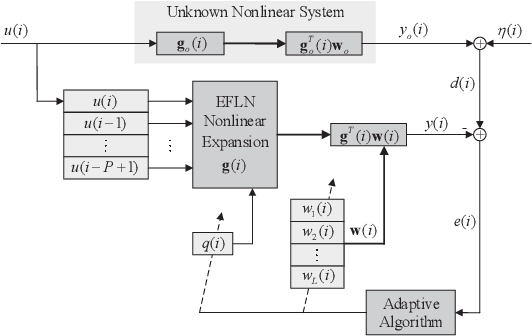
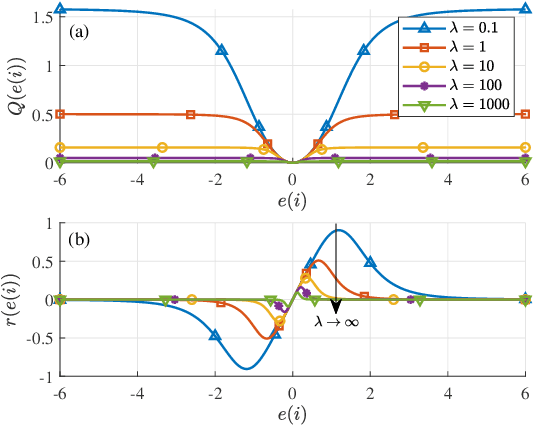
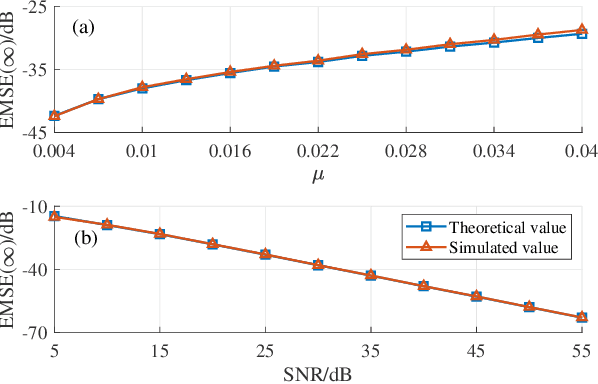
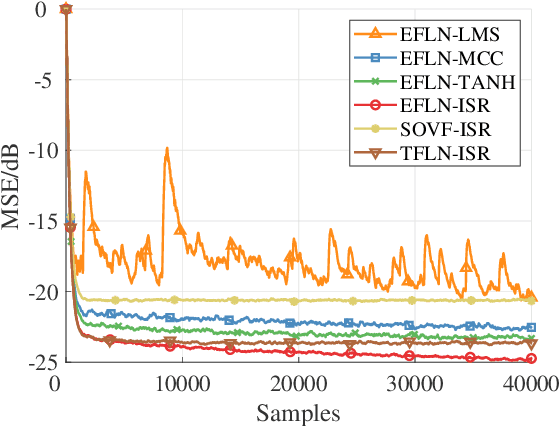
Abstract:The exponential functional link network (EFLN) has been recently investigated and applied to nonlinear filtering. This brief proposes an adaptive EFLN filtering algorithm based on a novel inverse square root (ISR) cost function, called the EFLN-ISR algorithm, whose learning capability is robust under impulsive interference. The steady-state performance of EFLN-ISR is rigorously derived and then confirmed by numerical simulations. Moreover, the validity of the proposed EFLN-ISR algorithm is justified by the actually experimental results with the application to hysteretic nonlinear system identification.
Answering Visual What-If Questions: From Actions to Predicted Scene Descriptions
Sep 11, 2018



Abstract:In-depth scene descriptions and question answering tasks have greatly increased the scope of today's definition of scene understanding. While such tasks are in principle open ended, current formulations primarily focus on describing only the current state of the scenes under consideration. In contrast, in this paper, we focus on the future states of the scenes which are also conditioned on actions. We posit this as a question answering task, where an answer has to be given about a future scene state, given observations of the current scene, and a question that includes a hypothetical action. Our solution is a hybrid model which integrates a physics engine into a question answering architecture in order to anticipate future scene states resulting from object-object interactions caused by an action. We demonstrate first results on this challenging new problem and compare to baselines, where we outperform fully data-driven end-to-end learning approaches.
 Add to Chrome
Add to Chrome Add to Firefox
Add to Firefox Add to Edge
Add to Edge